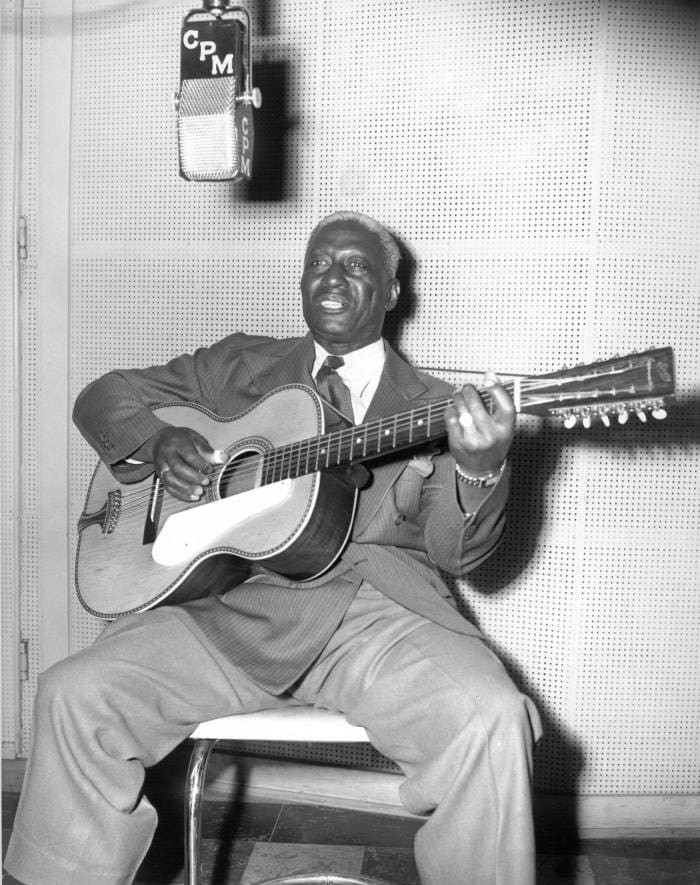“Where Did You Sleep Last Night” is a song shrouded in mystery and emotion, famously covered by Nirvana during their iconic MTV Unplugged performance in 1993. Kurt Cobain’s raw and haunting rendition, particularly his strained delivery of the final line, became deeply poignant after his death just months later, solidifying the song’s place in music history. While Nirvana’s version introduced the song to a new generation, its roots stretch back much further, weaving through the rich tapestry of American folk and blues music.
 Lead Belly, influential folk and blues musician known for 'Where Did You Sleep Last Night', performing with his guitar.
Lead Belly, influential folk and blues musician known for 'Where Did You Sleep Last Night', performing with his guitar.
Lead Belly’s Enduring Influence
Often credited for popularizing “Where Did You Sleep Last Night,” Huddie Ledbetter, better known as Lead Belly, was a pivotal figure in American folk and blues. Born in the late 1800s and living until the mid-1900s, Lead Belly absorbed a vast repertoire of songs through oral tradition, traveling extensively through the Southern United States. His life story is as captivating as his music; it includes periods of imprisonment before he was “discovered” by musicologists. They recognized his immense talent and helped launch his recording and performing career in New York City. Lead Belly recorded several versions of the song, sometimes titled “Where Did You Sleep Last Night” and other times as “Black Girl (In the Pines),” each carrying his signature powerful vocals and intricate guitar work.
Tracing the Song’s True Origins: Deeper Than Lead Belly
Despite Lead Belly’s significant contribution, “Where Did You Sleep Last Night” is not his original composition. The song’s true origins lie deep within the oral traditions of Southern Appalachian communities. As Dolly Parton herself attested, “the song has been handed down through many generations of my family. I don’t ever remember not hearing it and not singing it. Any time there were more than three or four songs to be sung, ‘In the Pines’ was one of them.” This highlights the song’s organic evolution within communities, likely emerging from Black communities near the Southern Appalachian mountains in the late 19th century. Early iterations even reference “Joe Brown’s coal mine,” pointing to a Georgia governor of that era, placing its genesis firmly in that historical and geographical context.
A Song of Many Faces: Variations and Recurring Themes
The enduring nature of “Where Did You Sleep Last Night” is evident in its numerous variations. Music researcher Judith Mculloh documented an astounding 160 different versions by 1970, and countless more have surfaced since. Each rendition offers unique lyrical nuances and thematic emphases, yet certain motifs consistently reappear.
The imagery of a train or railroad is almost ubiquitous across versions. Often described with hyperbole – “100 cars long” or taking “three hours to pass” – the railroad functions as a potent symbol, frequently foreshadowing misfortune. In some versions, the train signifies separation, carrying a lover away. In others, it becomes a harbinger of death, with individuals tragically meeting their end beneath its wheels.
Central to the song is the recurring question directed at a “girl” who has spent the night “in the pines.” The relationship to this girl fluctuates; she might be a lover, a daughter, or even a more symbolic figure. The “pines,” where she seeks refuge, become crucial to understanding the song’s emotional core. Is she hiding from wrongdoing? Has she committed adultery, or perhaps a more serious crime, seeking solace and concealment in the dense woods? Or is she a figure of hardship, driven to the pines by destitution and lack of shelter? Regardless of the specific narrative, the “girl in the pines” embodies the song’s overarching mood: haunting, melancholic, and burdened. Alone with her thoughts “in the pines, in the pines, where the sun never shines,” she represents a profound sense of isolation and despair.
The Lasting Resonance of “In the Pines”
“Where Did You Sleep Last Night,” or “In the Pines,” transcends any single definitive interpretation. Its power lies in its adaptability and its resonance with universal human emotions of loss, fear, and uncertainty. From its obscure origins in Appalachian communities to its global recognition through artists like Lead Belly and Nirvana, the song continues to captivate and move listeners. It stands as a testament to the enduring strength of folk music and its capacity to evolve and speak to new generations.
Works Cited
360, Studio. “The Haunting Power of ‘in the Pines.’” Slate Magazine, 19 Apr. 2019, slate.com/culture/2019/04/in-the-pines-song-kurt-cobain.html.
“American Routes – In the Pines.” American Routes, scholarblogs.emory.edu/americanroutes/lyrics/pines/. Accessed 2 June 2023.
“The Haunting Power of ‘in the Pines.’” The World from PRX, 18 Apr. 2019, theworld.org/stories/2019-04-18/haunting-power-pines.
“Lead Belly.” Encyclopædia Britannica, 6 May 2023, www.britannica.com/biography/Leadbelly.
Weisbard, Eric. “A Simple Song That Lives beyond Time.” The New York Times, 13 Nov. 1994, www.nytimes.com/1994/11/13/arts/pop-music-a-simple-song-that-lives-beyond-time.html?pagewanted=1.


